The Samsung Galaxy S21 Ultra & S21 Review: The Near Perfect and The Different
by Andrei Frumusanu on February 22, 2021 12:00 PM EST- Posted in
- Smartphones
- Samsung
- Mobile
- Galaxy S21
- Galaxy S21 Ultra
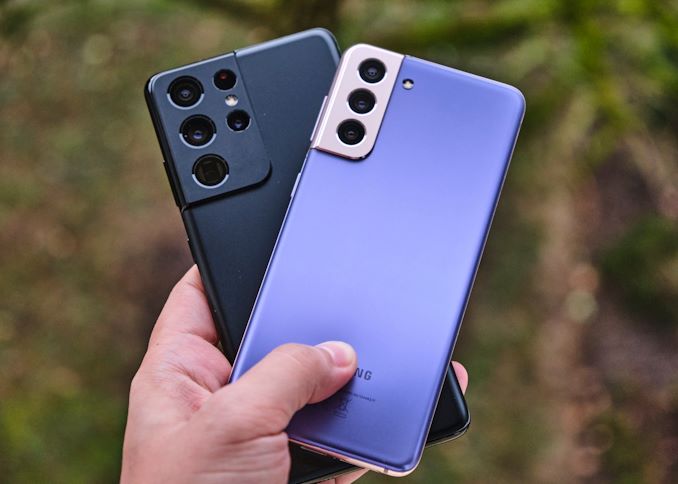
After many years of ever-increasing flagship device prices, this year Samsung is taking a quite different approach with the new Galaxy S21 series – not only stopping the price increases, but actually reducing this year’s flagship line-up prices compared to the 2020 predecessors.
This year, Samsung is also more notably differentiating the specifications of the devices – there’s still a base model, a larger “+” model, and the super-sized “Ultra” model, however only the Ultra model has managed to come out rather unscathed, with the two other traditional models finding themselves with technical compromises that we haven’t seen in past years, such as lower resolution, last-gen panels, different build materials and designs, on top of the usual different camera configuration.
Today we’re reviewing the Galaxy S21 Ultra in both Exynos and Snapdragon SoC flavours, as well the baseline Galaxy S21 – contrasting two very different devices in Samsung’s new series, coming in at two very different price points.
| Samsung Galaxy S21 Series | ||||
| Galaxy S21 | Galaxy S21+ | Galaxy S21 Ultra | ||
| SoC | Qualcomm Snapdragon 888 1x Cortex-X1 @ 2.84GHz 1x1024KB pL2 3x Cortex-A78 @ 2.42GHz 3x512KB pL2 4x Cortex-A55 @ 1.80GHz 4x128KB pL2 4MB sL3 |
|||
| Samsung LSI Exynos 2100 1x Cortex-X1@2.9GHz 1x512KB pL2 3x Cortex-A78 @ 2.8GHz 3x512KB pL2 4x Cortex A55 @ 2.2GHz 4x64KB pL2 4MB sL3 |
||||
| Display | 6.2-inch 2400 x 1080 (20:9) 48-120Hz 1300nits peak |
6.7-inch 2400 x 1080 (20:9) 48-120Hz 1300nits peak |
6.8-inch 3200 x 1440 (20:9) 10-120Hz 1500nits peak |
|
| SAMOLED HDR10+ 120Hz Refresh Rate |
||||
| Dimensions | 151.7 x 71.2 x 7.9mm 171g (mmWave), 169g (sub6) |
161.5 x 75.6 x 7.8mm 202g (mmWave), 200g (sub6) |
165.1 x 75.6 x 8.9mm 229g (mmWave), 227g (sub6) |
|
| RAM | 8GB | 8GB | 12 / 16GB | |
| NAND Storage |
128, 256GB | 128, 256 GB | 128, 256, 512 GB | |
| Battery | 4000mAh (15.4Wh) typ. 3880mAh (15.01Wh) rated |
4800mAh (18.57Wh) typ. 4660mAh (18.03Wh) rated |
5000mAh (19.25Wh) typ. 4855mAh (18.87Wh) rated |
|
| Front Camera | 10MP 4K video recording F/2.2, 80-degree |
40MP 4K video recording F/2.2, 80-degree |
||
| Primary Rear Camera | 79° Wide Angle 12MP 1.8µm Dual Pixel PDAF |
79° Wide Angle 108MP 0.8µm DP-PDAF 3x3 Pixel Binning to 12MP 8K24 Video Recording |
||
| fixed f/1.8 optics OIS, auto HDR, LED flash 4K60, 1080p240, 720p960 high-speed recording |
||||
| Secondary Rear Camera |
76° Wide Angle (Cropping / digital zooming telephoto) 64MP 0.8µm f/2.0 optics, OIS 8K24 Video Recording |
12° Telephoto (10x optical) 10MP f/4.9 prism optics, OIS |
||
| Tertiary Rear Camera |
- | 3x optical 10MP f/2.4 |
||
| Quartenary Rear Camera |
120° Ultra-Wide Angle 12MP 1.4µm f/2.2 |
|||
| Extra Camera |
- | Time of Flight (ToF) 3D Sensor | ||
| 4G / 5G Modem |
||||
| Snapdragon 5G TBC |
||||
| Exynos 5G TBC |
||||
| SIM Size | NanoSIM + eSIM | |||
| Wireless | 802.11a/b/g/n/ac/ax 2x2 MU-MIMO, BT 5.1 LE, NFC, GPS/Glonass/Galileo/BDS |
+ WiFi 6E | ||
| Connectivity | USB Type-C no 3.5mm headset |
|||
| Special Features | Under-screen ultrasonic fingerprint sensor | |||
| (Qualcomm QC 2.0, Adaptive Fast Charging, USB 3.0 PD PPS), reverse wireless charging (WPC & PMA), Ultra Wideband IP68 water resistance |
||||
| Launch OS | Android 11 with Samsung OneUI 3.1 | |||
| Launch Prices | 128GB 5G: $799 / €849 / £769 256GB 5G: $849 / €899 / £819 |
128GB 5G: $999 / €1049 / £949 256GB 5G: $1049 / €1099 / £999 |
128GB 5G: $1199 / €1249 / £1149 256GB 5G: $1249 / €1299 / £1199 512GB 5G: $1379 / €1429 / £1329 |
|
Starting off with the core hardware components of the new S21 series, the new flagships are amongst the first devices in the market powered by Qualcomm’s new Snapdragon 888 SoC as well as Samsung LSI’s new Exynos 2100. The two new silicon chips this year are more similar to each other than in previous years – both featuring almost identical CPU setups and both being manufactured on the same process node, only leaving more significant differences on the part of the GPUs and other multimedia design aspects.
Ahead of our full device review today, we spun off a dedicated SoC-centric two weeks ago which goes into more technical details of how this year’s new silicon chips perform as the baseline computing platforms for 2021 devices, so I would recommend readers mostly interested in those technical details to read that piece ahead of continuing with the other aspects of the new S21 series today.
As a short summary, I’d say that this year’s SoCs are to be viewed as smaller incremental improvements over last generation iterations – at least on the Snapdragon side of things which applies to north American variants of the new S21 series. Other global customers of the S21 series which will be seeing the Exynos variants being deployed in their devices, while not having fully caught up to the Snapdragon’s performance and power efficiency, will however see extremely large generational improvements compared to what we’ve seen in the Exynos-powered S20 series, so this year’s differences between the two SoC types will be smaller.
In terms of DRAM and storage configurations, the S21 and S21+ come with 8GB of LPDDR5 in either 128GB or 256GB storage configurations. The larger S21 Ultra features generally 12GB of RAM alongside its 128 and 256GB configurations, however also sees a 16GB top-of-the-line version with 512GB storage.
Samsung this year has dropped the microSD slot for storage expansion, marking the S21 series as the second time Samsung has removed this feature after the S6 series a few years ago. Back then, baseline storage capacities landed in at 32GB up to a maximum of 128GB, and Samsung had reintroduced the microSD slot in the S7 series which only went up to 64GB of internal capacity.
I’m not too sure what Samsung’s reasonings were with the removal of the slot on the S21 series this year – but I do have to admit I haven’t used a microSD in a few years now following increases of the baseline storage capacities of phones. A further consideration is that the industry has utterly failed to transition away from slow microSD cards onto newer standards. Samsung’s own UFS Card standard announced back in 2016 has seen zero adoption in the mobile market – I’m not actually aware of SoCs who actually sport a second UFS controller to actually enable these cards. I’m also not aware of any phone supporting the UHS-II microSD interface standard, so again quite standards failure here in the broader industry.
The silver lining here is that Samsung does employ 128GB as the base storage, and for the first time ever, the 256GB storage option upgrade this year only costs $/€/£50 – a much cheaper upgrade not only compared to past years, but also cheaper than the up-sell many contemporary competitors are offering today, and for the first time an upgrade that I would consider of actual good value and which I wouldn’t hesitate recommending.
In terms of other feature discrepancies between the S21 Ultra and its cheaper siblings, one of note is that the new model is the only one in the line-up which features a new Broadcom WiFi 6E compatible BCM4389 chipset, whereas the S21 and S21+ features the same WiFi 6 module from last year. This is the first time Samsung has actually differentiated the models within a flagship series in this manner – so although WiFi 6E isn’t widespread yet and most users likely are still lacking a proper compatible router, it does mean the Ultra is theoretically more future-proof in this regard.
For US users particularly, one other feature removal of the S21 series is the lack of MST payment options. This should be largely irrelevant in most of the rest of the world, but Samsung is removing an important and unique differentiation factor for the S-series in America – if you’ve been relying on it for smartphone payments, it’s something to keep in mind as it’s now gone.
The Galaxy S21 Ultra – The True Flagship
As we’ve noted, Samsung’s differentiation between the various S21 models is greater than ever before – making the new S21 Ultra the only real (almost) no-compromise device in the series this year. In many regards, the new Ultra is actually the new pinnacle of smartphone flagship technologies, with Samsung going all-out in almost every aspect.
Starting off with the biggest ticket item on the spec list, the new S21 Ultra’s display is the most technically impressive piece of technology in the new phone. Still at QHD 3200 x 1440 resolution, Samsung now also actually allows native software rendering at the full 120Hz refresh rate.
Furthermore, this is now as Samsung calls it an “Adaptive Refresh Rate” display, which in the S21 Ultra implementation not only means coarse software-based refresh rate switching between 60 and 120Hz modes, but also fine-grained transparent hardware-based LFD (low frequency drive) refresh rate switching down to 10Hz. Although with a few quirks, this is currently the most cutting-edge high refresh rate display implementation in any mobile phone in the market right now, essentially solving almost all battery draw concerns of the much-praised 120Hz HFR mode of modern flagships. It really seems to be an outstanding display in every regard.
On top of the new high-refresh rate technologies, the S21 Ultra is also the first phone OLED display to employ a new generation emitter material, allowing it to go significantly brighter, or to be much more power efficient with its luminosity compared to other displays in the market. It really seems to be an outstanding display in every regard.
In terms of design, the front face of the new Galaxy S21 Ultra is nearly indistinguishable from that of the S20 Ultra – it’s still a large glass panel with gently curved sides with minimal bezels in every direction, as well as a central front-camera hole-punch design which doesn’t look to have changed from last year’s model.
The new phone is actually 1.8mm shorter and 0.4mm narrower this year, and Samsung does say the display is now 6.8” instead of 6.9”, however for other design reasons we’ll go into in a bit, this actually isn’t immediately noticeable.
The big new fresh design element of the new S21 series has to be the new camera layout as well as the “camera island”. Unlike the hodgepodge camera design of the S20 Ultra which looked like a last-minute attempt to cram in as many cameras as possible into something manufacturable, the new S21 Ultra camera layout feels extremely well though-out in terms of its looks, and how it integrates into the rest of the phone body. The whole camera “island” has a metal cover protecting it, rather than a larger glass piece over all the cameras, with the new design featuring individual recessed glass pieces over each camera module.
The new design partly solves one issue with these new huge camera bumps – the edges of the camera island, by fully integrating itself into the corner of the phone and seamlessly melting with the actual side-frame of the device. This does mean however that the side-frame in that corner of the phone is hilariously thick, however I still much prefer this kind of design over previous attempts – it much more embraces the cameras rather than trying to accommodate for them.

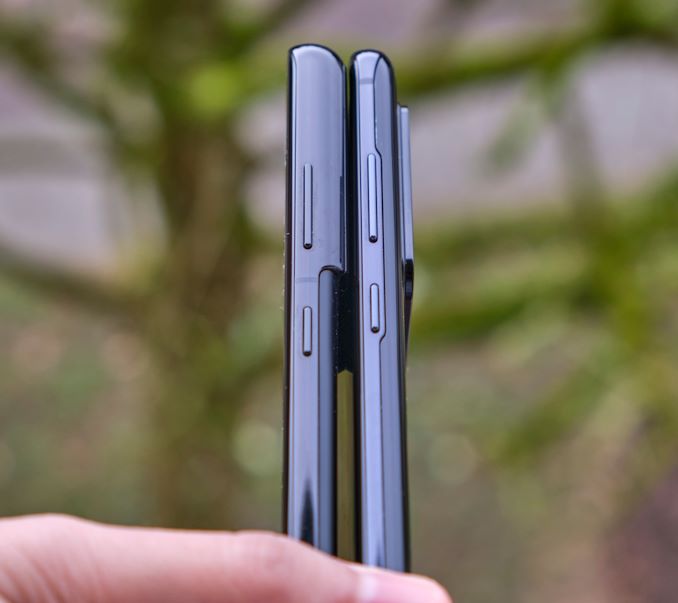
S21 Ultra (left) vs S20 Ultra (right)
One aspect that I didn’t see being talked too much about the new S21 Ultra is its general ergonomics and the design of the side-frame and back panel. Unlike the S20 Ultra, the new phone actually has now a thicker side frame on the sides of the phone, whereas the S20 Ultra had more of the glass back panel flowing further towards the sides. I had expected the S21 Ultra to feel smaller than the S20 Ultra, however because of this new frame design this actually isn’t the case, as the back curvature this year is much less pronounced.
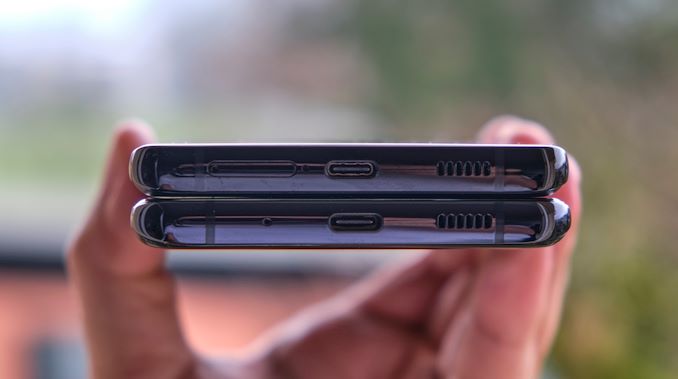
S21 Ultra (top) vs S20 Ultra (bottom)
The top and bottom frame is also less rounded than the S20 Ultra, and in general I’d say this makes the phone feel thicker than before, even though both generations are measuring at the same 8.9mm body thickness.
One last thing I wanted to comment on the S21 frames is the fact that they feel more grippy and have more friction to them. Although both are glossy finishes, the S21 (on purpose or not) has more friction to it, and also does for this reason more easily collect dirt and fingerprints.
The Galaxy S21 - The Cheaper Not-Quite Flagship
The new Galaxy S21 is this year’s weird new little flagship for Samsung. This year we opted to buy the smaller S21 rather than the more usual “+” model as we wanted to give the new device a try-out, as it does have some unique design elements.
Again, much like on the Ultra, the new S21’s key differentiating feature is its design. Samsung has opted to go with a very different screen panel and general screen design for this year’s S21 and S21+ - going lower resolution as well as going for fully flat glass.
In terms of the panel itself, I immediately questioned Samsung’s choice of going with a FHD-class display, after essentially 5 years and generations of 1440p panels on the S-series. I am able to say that I did notice the change quite immediately, even though we’re talking about the smaller S21 - the larger S21+’s display will make the resolution difference likely even more of a point of contention.
The panels on the S21 and S21+ don’t have the fancy new features the S21 Ultra has. It’s still the same emitter generation as on the S20 series, meaning it has the same brightness and efficiency, and it lacks the more advanced LFD high-refresh rate power management, although the “Adaptive Refresh Rate” mode this year does actually work on a software granularity and has that going for itself versus the S20’s series constant 120Hz mode.
In general, the display design here isn’t bad – it’s still a great display, and I do feel it has generational advantages such as better viewing angles and a seemingly better lamination, giving it a more popping sticker effect. The flat display and the lower resolution do however feel very conventional, and not-quite flagship like.
The phones this year are cheaper than their predecessors, but I feel like Samsung here is compromising on one of the most defining aspects of the Galaxy S series – having uncompromising best-in-class displays, no matter the model you chose. Other than the software adaptive refresh rate mode, I don’t feel like the S21 display is any better than the S20’s, and in terms of build quality, subjectively feels worse and cheaper. You might argue or not if that makes sense on the S21, but the S21+ is still a $1000/€1049 phone, competing with the likes of the Xiaomi Mi 11 which now has a better screen design and specifications at only €749. The whole design decision gives me very mixed feelings, and I’m still not too sure on the general conclusion of the matter.
The back panel of the S21 is made of plastic, which had been a contention point ever since Samsung reintroduced the material in their flagship series with the Note20. After having experienced the device first-hand, I can say that it’s absolutely not an issue. In fact, you might very well be fooled about what the material actually is, were it not for the temperature behaviour – glass still noticeably feels cooler than plastic.
In terms of texture, the matte finish works extremely well, but it is quite different to that of the glass S21 Ultra and S21+ - it has much more friction to it and just isn’t as smooth, but that’s about it when it comes to the differences. I haven’t had the phone long enough in daily usage to talk about one contention point of the new plastic material: long-term durability and scratch resistance. I still remember past plastic Galaxy phones suffering from scratches and abrasions due to use – we’ll have to see how the S21 fares after several months or a year.
The camera island on the S21 is brilliant in its design. Much like on the S21 Ultra, this is an aluminium cover that protects individual recessed glass elements for the three main camera modules. Samsung harmonised the camera design between the S21 and S21+ by dropping the ToF sensor from the latter in comparison to the S20+ - which is fine by me as frankly I never really used it even though it was my daily driver for the past year.
Streamlining the camera design around the three main modules and pushing them towards the corner works extremely well when it comes to aesthetics, and Samsung really hit it out of the park here with the S21 as it achieves in my opinion an attractive and very unique look, especially on this violet-gold variant of the phone.
Probably the only gripe I have here is that Samsung should probably swap the ultra-wide-angle module away from the corner from the phone with one of the other modules – I’ve caught myself with my fingers in the camera frame a few times.
Much like on the S21 Ultra, the frame of the phone isn’t quite as round as on the S20 series. This is particularly important for the S21+ which this year has grown from 73.7mm width to 75.6mm, and also increasing its weight from 187g to 202g – it’s no longer the medium sized model to the Ultra, but actually essentially the same footprint although it is 1.1mm thinner. This increase in width along with the flat display means the S21+ really can’t be compared to the S20+ in terms of form-factors, especially when the S21 Ultra has the same footprint now.
Overall, then new S21 series this year are quite brave divergences for Samsung. The new camera design and layout in my opinion are fantastic. The S21 Ultra also looks great, although it’s a massive device by nature. The S21 and S21+’s new screen designs still give me mixed feelings, and although the new lower price points seem to be working well for Samsung, I do feel it a pity to see the series compromise in its defining features.


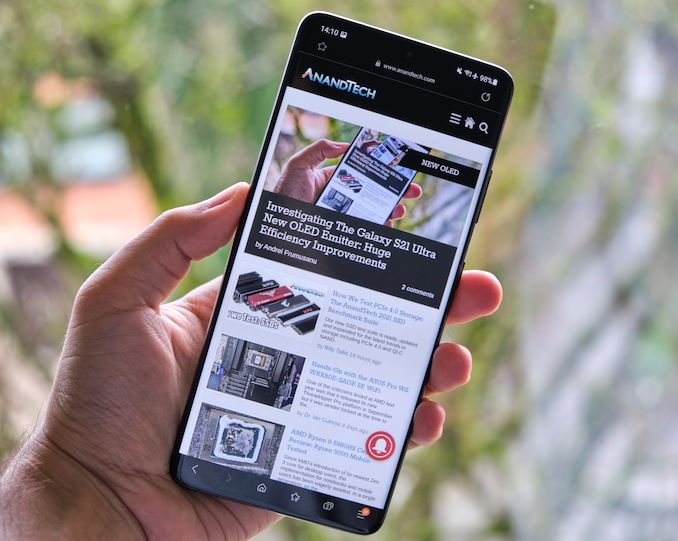
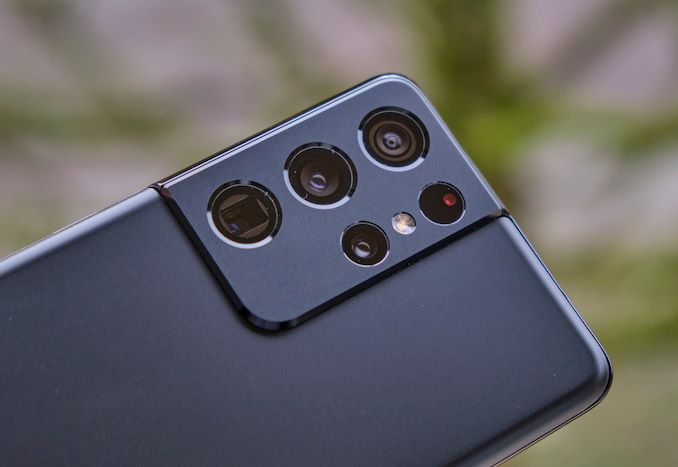
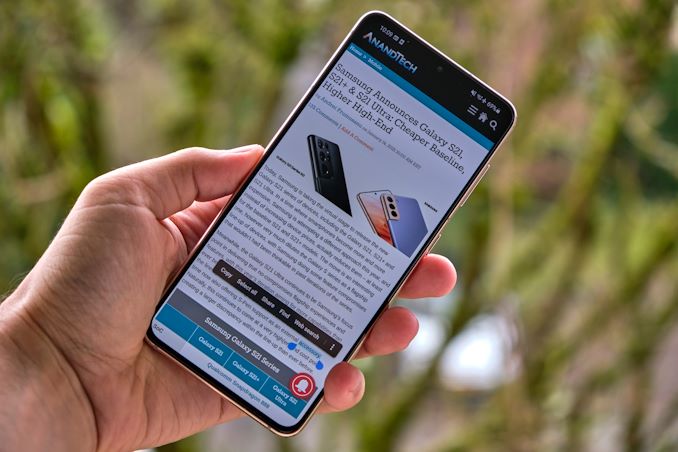
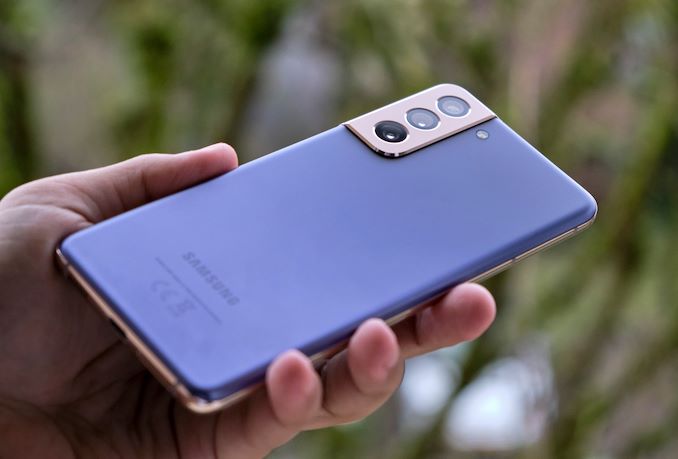
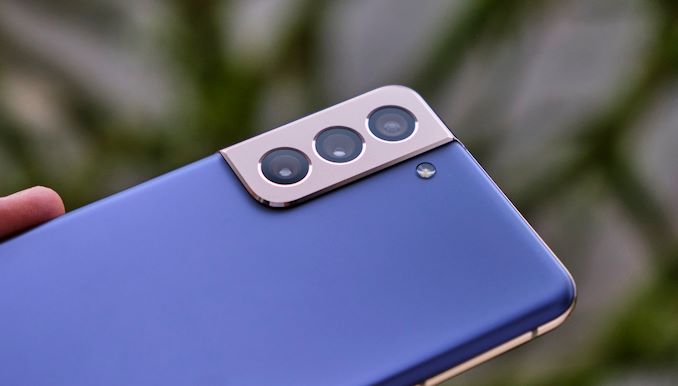

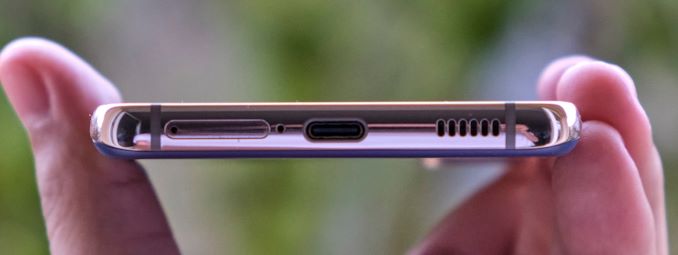








122 Comments
View All Comments
sanjeev2.k - Monday, February 22, 2021 - link
I am assuming system wide dark theme was not turned on during battery life test. So by how much roughly will the battery life improve if dark mode is turned on?Andrei Frumusanu - Monday, February 22, 2021 - link
It doesn't affect our tests, unless I also enable the browser dark mode.jhoff80 - Monday, February 22, 2021 - link
I mostly like my S21 Ultra a lot, but I still hate a lot about the software. Even as OneUI has improved greatly over the years, there's some really stupid stuff here or there. Like I should be able to disable or uninstall Samsung's duplicate apps (calendar, contacts, clock, etc.) without adb. But that's fine, there's a workaround for that, so that's just annoying.What really annoys me that I can't work around as far as I'm aware is that I can't disable half of the unnecessary notifications that Samsung gives me. Like constant notifications when my Bluetooth headset battery is low (and if I swipe them away they come right back for each percent lost). Or a notification for do not disturb being on (even though DND is in my quick settings). Or a notification that I need to unlock my phone after a reboot to see more notifications. Android has settings to turn notifications off, but Samsung doesn't let me flip the switch on ones they think I need to be forced to see.
And other than that, I dislike the scoped storage issues with Google Photos, and the fact I can't set Samsung's camera app to go directly to Google Photos instead of their inadequate Gallery app. And I'm slightly disappointed that the S21 removed ANT+ support. And I hate that I can't set the power/side button to the devices menu like I did with my Pixel 4XL. But I worked around that with sideActions set to go directly to SmartThings instead.
But still, overall I really like it. It's faster than my Pixel 4XL, has a better camera (though I continue to dislike Samsung's post-processing in general, it sometimes smears things), I missed having the capability to use the S-pen compared to my even older Note8, and the fingerprint reader over face scanning is a huge bonus in the Covid era.
I just really don't get why Samsung wastes their time on duplicate apps nobody wants, or why they prevent the user from actually taking control over their experience. Oh well. At least there's workarounds for most of it.
Edwardmcardle - Friday, February 26, 2021 - link
They messed up the split screen multitasking imo. It's still has the advantage of keyboard pop not bumping the top half off the screen, but swiping home now minamises BOTH screens , where it should normally only minimise the active screenWereweeb - Monday, February 22, 2021 - link
Yeah, they really f*cked up with the screens. Less than 400 PPI in an S-series? My last Sammy was an S6 Edge, and that f*cking thing had a 577 PPI screen.Sure, younger me couldn't really tell the difference to a good 1080p 5-incher, but it simply doesn't make sense to decrease the resolution *after* display sizes have increased so much that the sharpness of QHD is actually noticeable to the average user.
Glad they added back a flat screen option, I've always despised curved displays (I didn't buy that S6 Edge, it was handed down). But all in all, it sounds more like an A92+ than an S21.
Retycint - Tuesday, February 23, 2021 - link
To make things worse, it's a pentile/non-full-rgb matrix, so it's going to look worse than a 1080p LCD of the same size. Why pay $1000 when you can get a QHD 120Hz in the Mi 11 for a couple hundred less?DJ XtAzY - Monday, February 22, 2021 - link
Anything on the video quality, or was that in a different article?BedfordTim - Tuesday, February 23, 2021 - link
Also anything about the fingerprint sensor? Poor Amazon reviews were one of the reasons I chose a P30Pro over the S20 last time.Edwardmcardle - Friday, February 26, 2021 - link
I think the ultrasonic is the best available, works with screen off and this generation is exceptionally fast and accuratebcronce - Monday, February 22, 2021 - link
I saw USCC now has unlimited plans that were cheaper than the plan I was on. The wife went in to switch our lines over and came back with an S21 basic for me to place my S7. At $13/m over a 30 month contract, we will only be paying $400 for the phone.My last plan was technically unlimited, but only in the sense that going over 2GB would drop me into 3G speeds with no overage. But now with truly unlimited, I no longer have artificial caps on speed, only have to compete with congestion. For an extra $10/m, I could get 25GB of "high priority" data, and $20/m extra, 50GB. I'm fine with best effort and no artificial limits.